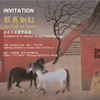分享到微信,
请点击右上角。
再选择[发送朋友]
或[分享到朋友圈]

2022-09-28 22:03

展览名称:似真如幻——余启平水墨作品展
开幕时间:2022年10月1日(周六)下午15:00
展览时间:2022年9月28日至10月30日
展览地点:艺栈画廊,北京798东街#D10
ICI LABAS艺栈画廊将于2022年9月28日-10月30日,举办”似真如幻-余启平水墨作品展“,展出画家余启平近几年创作的数十幅水墨作品。

沐烟图

罗汉图

宫墙二月风 44x63cm
余启平的绘画好就好在似真如幻,并不‘真实’的图像及其人物上,那种憨态、那般狡黠、那股迷离、那番入定,假作真时真亦假,入乎其内,披图入情;出乎其外,观其高致。一半痴迷一半间离,捉迷藏一般捉摸不定,有如看着余老师戴着红色时尚镜架的含笑的脸靥一半是学者的深沉一半是艺术家的幽默,其实内里根本的是一半是海水,一半是火焰。
艺术评论家徐明松
Yu Qiping's paintings are as good as they look real as illusions, however, their images and figures depicted seem to appear to be not 'real', producing a kind of humble, cunning, confusing, serene sense, looks like when it is false, it might be true or vice versa. If you go inside the image, you will be in love with it; if you go away from the image, you will enjoy its elegance. In your eyes, the image might be half obsessed, half alienated, unpredictable like hide-and-seek, just like watching Mr. Yu's smiling face wearing a red fashionable frame, half a scholar's deepness, half an artist's humor. In fact, what's inside is half sea water and the other half flame.
Xu Mingsong, an art critic
余启平给我们铸造了一个懵懂的世界,它内敛、含蓄、沉酣,但在世的真理却绽放着,它能唤起你的宁静感,对于持存之物的专注和渴念,冲突被消解了,化成了对本真抒情的渴求,对神秘欢乐的向往——在这里智慧是没有意义的,真正有意义的是对审美生存的沉酣。

且为东风住 46x49cm

问西风

记得去年秋
这种追求也体现在余启平的绘画技巧上,他深刻地理解了中国画的种种传统技法,但是,又对他们做了现代主义的改造,并在此基础上形成了自己独特的绘画语汇,这种语汇构成了“新东方主义”审美倾向的语汇基础。我非常喜欢余启平的这种绘画美学:一种渗透着极其浓厚的新东方意味的风格和倾向。它不是佛家禅意的简单复归,也不是道家出世思想的再现,而是在现代背景之下,通过对机械、拥挤、忙碌、无谓等在世状态的规避,而显现出的对人的本真在世状态的追求和阐释,我将它命名为“新东方主义”绘画:它追求的是无我不分、浑然未醒、混沌整一。
葛红兵 上海大学文学院
Yu Qiping has created vague world for us. It is introverted, reserved, and intoxicated, but the truth of the world is blooming. It can arouse your sense of tranquility, focus and desire for the things that persist, and conflicts are dissolved and turned into the thirst for authentic lyricism, the yearning for mysterious joy – wisdom is meaningless here, and what is truly meaningful is the indulgence of aesthetic existence.
This pursuit is also reflected in Yu Qiping’s painting skills. He has a deep understanding of various traditional techniques of Chinese painting, but has made modernistic transformations to them; on this basis he has formed his own unique painting vocabulary. This vocabulary constitutes the lexical basis of the aesthetic tendency of “Neo-Orientalism”. I like his painting aesthetics very much: a style and an inclination permeated with a very strong new oriental meaning. It is not a simple return to Buddhist Zen, nor is it a reproduction of Taoism’s thought of detachment from the world, but in a modern context. Through the avoidance of mechanical, crowded, busy, useless and other living conditions, it shows the true nature of human beings, the artist intends to reveal the pursuit and interpretation of the state of being human beings in the world. I named it “New Orientalism” painting: what it pursues is nothingness, unawareness, chaos and unity.
Ge Hongbing
School of Liberal Arts, Shanghai University
翻译:晋华
translated into English by Jin Hua
校对:托尼 • 布朗教授
Polished by Professor Tony Brown

分享到微信,
请点击右上角。
再选择[发送朋友]
或[分享到朋友圈]

